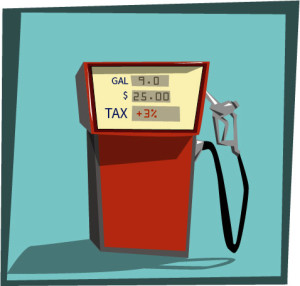American infrastructure is in trouble. Years of neglect have left many roads, sewers and dams in questionable condition, posing serious risks to both productivity and safety. From cracks in Washington’s Wanapum Dam to the 2003 blackout, in which 55 million in the Northeast and Canada lost power, to the deteriorating 19th century sewage systems of DC, infrastructure problems continue to make headlines and create problems in the daily lives of Americans. And yet, it’s only when a calamity occurs — like the 2007 collapse of the I-35W in Minnesota that dropped 50 vehicles into the Mississippi River, killing 13 and injuring 145 more — that infrastructure issues receive the attention they deserve.
Last year, the American Society of Civil Engineers (ASCE) report card gave the United States a “D+” for its infrastructure, noting that 24.9 percent of American bridges were considered “structurally deficient” or “functionally obsolete.” The report projected that an investment of $3.6 trillion would be necessary to adequately repair roads, bridges and dams by 2020. While the ASCE is an admittedly biased source on the matter, these statistics are still a shocking reminder of just how long the road to sustainable infrastructure stretches. And solutions aren’t coming fast. The problem is exacerbated by a Highway Trust Fund that is on course for insolvency, with some predicting the end of August 2015 as the fated date. As the government quickly runs out of time to replenish the fuel needed for infrastructure upgrades, funding for infrastructure maintenance is becoming all the more pressing.
Though the need for funding is clear, where it will come from is less so. One frequently discussed and highly controversial option is to raise the federal gas tax, which is the driving force for the Highway Trust Fund. The tax hasn’t been adjusted since 1993 — when it was set at 18 cents per gallon — despite rising prices at the pump. Because of inflation, it’s as if the tax has suffered a 39 percent decrease over the past 20 years. Fortunately for advocates of a tax hike, the significant drop in crude oil prices in recent months has made an increase in the gas tax more palatable. And the tax hike has advocates, such as Senators Bob Corker (R-TN) and Chris Murphy (D-CT) who have proposed a 12-cent increase in the gas tax over the next two years. The proposal comes with an offer of $190 billion in tax relief designed to satiate both individuals and businesses and to bolster the tax’s political viability. But Corker and Murphy’s legislation is swerving off course. The proposed hike is both unpopular and myopic; Americans drive less now than ever before. And since federal mileage per gallon requirements have risen, cars are using less gas, meaning that the tax increase, in addition to possibly alienating constituents, would merely postpone a firm resolution to the funding issue.
Another proposal backed by Democrats suggests generating revenue for infrastructure projects by closing corporate tax loopholes. In 2013, President Obama unveiled the Grow America Act, which sought to create a $478 billion infrastructure fund financed by a “one-time 14 percent transition tax on up to $2 trillion of untaxed foreign earnings that US companies have accumulated overseas.” Obama’s idea, however, has failed to garner support among congressional Republicans and is stuck in the slow lane — though, if it did succeed, it would likely provide the means to temporarily fund significant infrastructure investment. But corporate loopholes are essentially off the table, since any realistic proposal will need to have strong support on both sides of the aisle.

Both raising the gas tax and closing corporate loopholes are options for temporary sources of funding, but the solution to America’s infrastructure problem will likely have to be radical and far-reaching. One bipartisan proposal, the Partnership to Build America Act, could present an answer. The act would create the American Infrastructure Fund (AIF), stocked by the sale of $50 billion worth of infrastructure bonds paying 1 percent interest. As an incentive to purchase the bonds, corporations would be allowed to repatriate a certain percentage of their overseas tax money for every $1 invested in these bonds. Analysts have concluded that the AIF could potentially yield $750 billion to fund infrastructure repairs. In addition to providing this extensive funding source, the bill’s structure would drive both private and public-private investment in infrastructure. Bonds have the additional benefit of providing not just immediate funding, but sustainable funding — something crucial to the long-term projects and repairs that the United States needs. Furthermore, the bill seems to have rare political viability, since the Partnership to Build America Act has garnered significant bipartisan support in the House and is already cosponsored by a healthy mix of 39 Republicans and 36 Democrats.
A $750 billion investment in US infrastructure would certainly ease the worries of Americans driving over functionally obsolete bridges on their daily commutes. But the money would do even more than that. It would have the potential to increase economic productivity and create jobs; the Economic Policy Institute predicts that even $250 billion alone in infrastructure investment could “support more than 2.2 million jobs” and provide a substantial $313 billion boost to US GDP. The Bureau of Labor Statistics corroborates the economic importance of infrastructure investment, noting that the construction sector, which was hit especially hard during the Great Recession, still faces unemployment levels of around 8 percent.
But the bill has its detractors. Critics argue that allowing companies to repatriate money held overseas will reward corporate actors who dodge taxes through offshore accounts. Furthermore, the National Bureau of Economic Research has concluded that the investment model used by the bill could have detrimental effects. The Bureau examined the 2004 Homeland Investment Act, which was marketed as a way to spur short-term job creation and which used a similar model to that of the Partnership to Build America Act. The report found that the funds mainly benefited shareholders through dividend payouts, accomplishing little constructive progress. Though Congress has said that it would never repeat the 2004 “tax holiday,” it is possible that the Partnership to Build America Act would continue this dangerous precedent by primarily benefiting shareholders at the expense of American taxpayers.
Others have also criticized the AIF’s funding mechanism as inefficient and fiscally irresponsible. Given the specific structure of the bond, and the AIF’s pledge to raise a minimum of $50 billion, there is a good chance that the government will actually lose money through the program. Based on predictions by the Joint Committee on Taxation and the Economic Policy Institute, the value of the lost tax revenue from repatriated funds could end up larger than the $50 billion that the bonds will raise. Besides the economic argument, others are unhappy with the bill’s repatriation technique for more qualitative reasons. Political blog The Hill asked, “Why are we rewarding bad behavior?” Essentially, the AIF has lost support by rewarding companies that hide their finances overseas, a technique that hurts small businesses and is generally considered poor practice.
Despite its drawbacks, the AIF may be worth a shot, since the United States needs to invest in its infrastructure — and quickly. Today’s low interest rates will not be around forever, especially as the Federal Reserve begins to tighten its policy. As a result, Congress needs to act decisively to take advantage of current economic conditions. In some ways, the bill seems to have run out of fuel — not much progress has been made since its introduction in 2014. It was mentioned explicitly in Obama’s 2014 State of the Union, but was left out of the 2015 address. Perhaps a modified Partnership to Build America Act — one that doesn’t rely on repatriation — would provide an opportunity to curry favor across the political median. The Highway Trust Fund’s ticking clock may drive Congress to do the improbable: pass a bill that will make much-needed investments in our roads, dams and bridges — without requiring a raise in taxes.
Art by Emily Reif.
